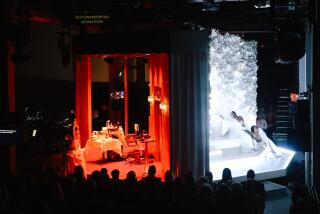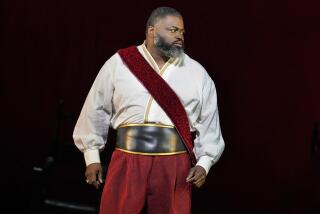Conte’s Beacon Lights Up the Century
- Share via
Paolo Conte is the perfect turn-of-the-century voice. Looking back to the turbulent currents of expression coursing through the early part of the 20th century, he proposes a music that simultaneously acknowledges those currents while propelling them into the next millennium.
Too grandiose a description for a 62-year-old performer who doesn’t appear to do much more than sit behind his piano and growl out songs about life and love and music and the changing seasons? Not in the case of Conte, who is one of the music world’s originals.
Monday night, at the Conga Room, in his West Coast debut and the opening stop in a four-city tour, he gave a performance to remember. Seated behind his piano at stage center, surrounded by a versatile seven-piece ensemble, he said almost nothing, allowing an hour and a half’s worth of songs to speak for themselves. Graying, with a world-weary face, he delivered them in spoken-sung fashion, occasionally, and unexpectedly, using a kazoo to toss in improvised horn simulations.
The songs, many from his first American album, “The Best of Paolo Conte” (Nonesuch), were filled with jazz elements, mostly from the pre-World War II period, many tinged with European elements--traces of Django Reinhardt, brief hints of Edith Piaf. Although they were all sung in Italian, Conte often tossed in English phrases--”It’s wonderful!,” “Oh, yeah,” etc.--as well as his own utterly unique style of scat singing.
Many in the packed-house crowd appeared to understand Italian, but even for those with only a slight understanding of the language, numbers such as “Via con me,” “Sotto le stelle del jazz,” “Gelato al limon” and “Come di” contained lyrics that were epigrammatic enough to communicate their meanings.
Either way, Conte’s presentation, the complex looks that crossed his lined visage and the dramatic qualities of his articulation were more than enough to convey his messages.
Equally important, the musical settings were, without exception, superb, ranging from romping, New Orleans-style exclamations to boogie-woogie, from passages reminiscent of Sicilian town bands to late-night cabaret music. And the musicians, doubling on a variety of instruments, delivered throughout, both as soloists and as ensemble players, with the remarkable Massimo Pitzianti bouncing around the stage to play accordion, clarinet and soprano and baritone saxophones.
But Conte was the engine that drove it, the heartbeat for a rare and wonderful performance. And he is correct to insist that music like this has a rightful place in the passage to the new century.
More to Read
The biggest entertainment stories
Get our big stories about Hollywood, film, television, music, arts, culture and more right in your inbox as soon as they publish.
You may occasionally receive promotional content from the Los Angeles Times.










